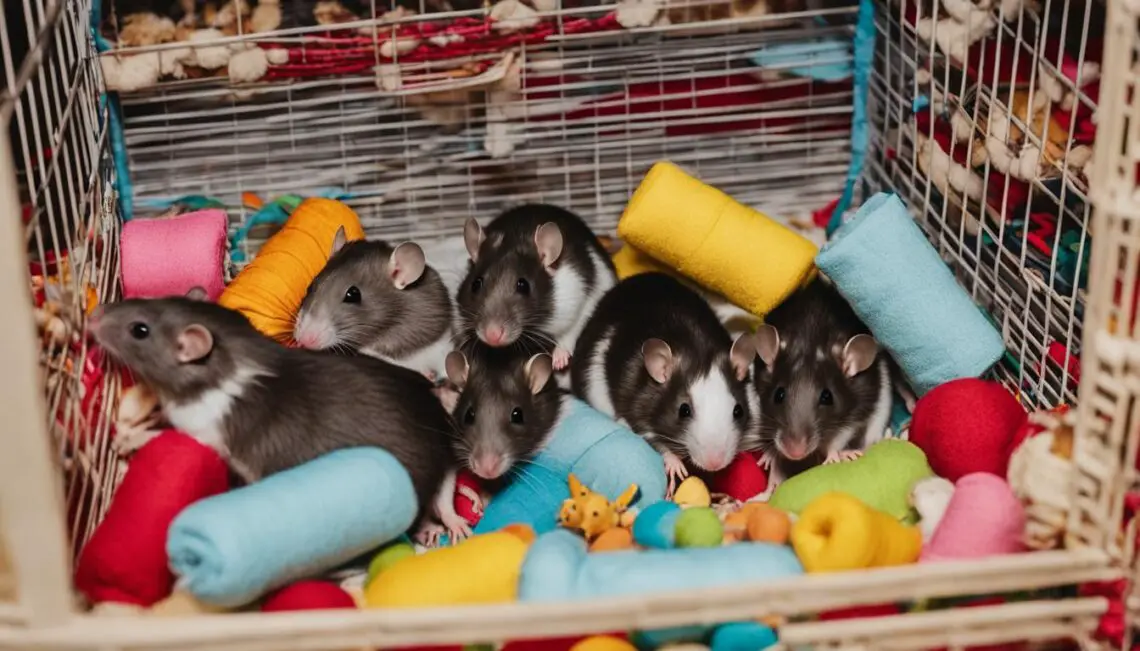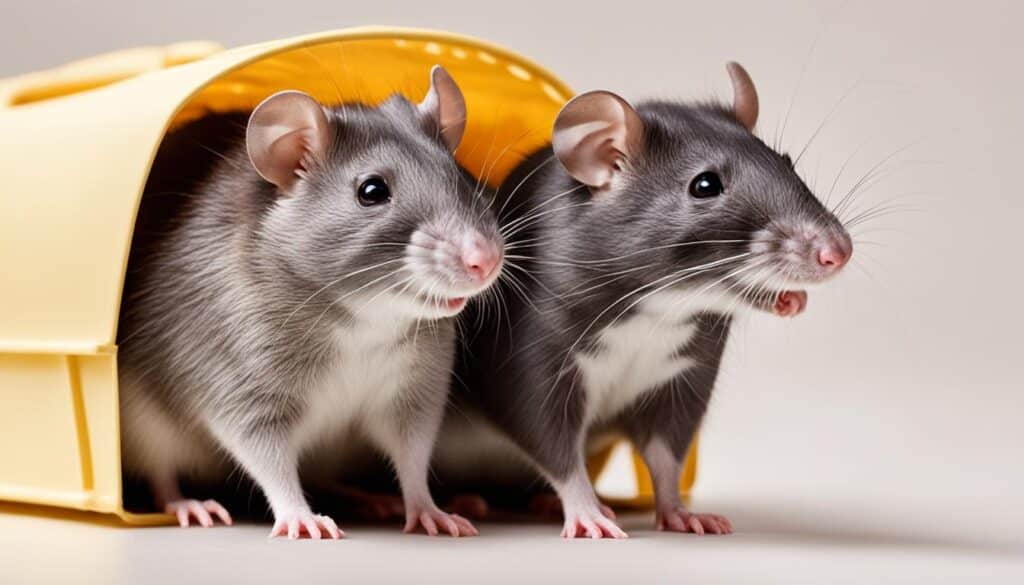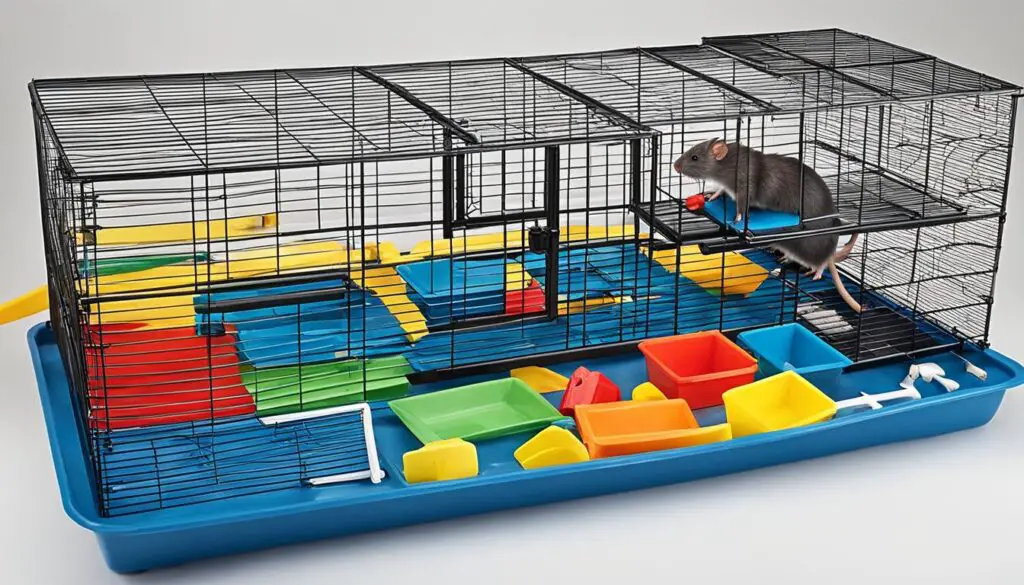Gaining a deep bond with your pet rat is a rewarding experience that requires patience, understanding, and effective socialization techniques. By understanding the natural social behavior of rats and implementing the right bonding strategies, you can create a strong connection and trust with your furry friend. In this article, I will explore the secrets to successful rat socialization and bonding, providing you with valuable insights and techniques to strengthen your relationship with your pet.
Key Takeaways:
- Understanding rat social behavior in the wild is crucial for effective socialization techniques.
- The carrier method of introductions is a reliable technique for introducing rats to each other.
- Providing an enriched living environment with ample space and toys stimulates rats’ physical and mental well-being.
- Patience, consistency, and positive reinforcement are key to building strong relationships with pet rats.
- By following these strategies, you can establish fulfilling and rewarding interactions with your pet rats.
Understanding Rat Social Behavior in the Wild
Wild rats exhibit fascinating social behavior and live in large colonies with structured subgroups. These subgroups consist of pairs, harems, unisexual groups, and single males and females. Their interactions within these subgroups play a vital role in their social dynamics and overall well-being.
One significant aspect of wild rat social behavior is their complex burrow systems. These burrows serve as not only nest sites but also food storage areas. They are intricately designed and provide shelter, protection, and a sense of security for the rats.
In order to successfully socialize and bond with pet rats, understanding their natural social behavior in the wild is crucial. By gaining insight into their colony structures, subgroup dynamics, and burrow systems, rat owners can create an environment that replicates their natural habitat, promoting better social interactions and mental well-being.
Comparison of Wild Rat Social Groups
| Group | Composition | Role |
|---|---|---|
| Pairs | One male and one female | Mating and rearing offspring |
| Harems | One dominant male and multiple females | Mating and protection of the dominant male |
| Unisexual Groups | Multiple males or females | Cooperative foraging and defense |
| Single Males and Females | Individual males or females | Solitary behavior |
By recognizing the different social groupings and the roles they play, rat owners can create appropriate socialization strategies, ensuring that their pet rats receive the necessary companionship and social stimulation they require for a happy and fulfilling life.
The Carrier Method of Introductions for Rat Socialization
The carrier or small space method is a reliable technique for introducing rats to each other. It involves starting with introductions in a small neutral space, then moving to an empty carrier or small cage until the rats are settled. This method allows rats to work out their hierarchy quickly and reduces the chance of injuries during introductions. It is particularly effective for rats that are hierarchy-driven and works well in most situations, but may not be suitable for aggressive or territorial rats.
The carrier method provides a controlled environment where rats can interact and establish their social dynamics. By starting in a small neutral space, such as a separate room or a sectioned-off area, the rats are introduced to each other’s scents and presence without feeling overwhelmed. This initial step helps to familiarize them with the new companions before moving on to a smaller space.
Once the rats are comfortable in the neutral space, the next step is to transfer them to an empty carrier or small cage. This confined space limits their movements, forcing them to interact closely and establish their hierarchy. It also prevents any escapes or overwhelming territorial behaviors that may arise in a larger space.
The carrier method is effective because it allows rats to establish their dominance and hierarchy quickly. By providing a small and controlled space, the rats have limited options for avoidance or aggression, promoting faster socialization. It also reduces the chances of injuries as the rats cannot run away or chase each other extensively.
It is important to monitor the interactions closely during the carrier method introductions. While some initial squeaking, chasing, and mounting behaviors are normal, excessive aggression, biting, or prolonged fights should be immediately addressed. Separating the rats and seeking guidance from an experienced rat owner or a veterinarian is advised in such cases.
In conclusion, the carrier or small space method is an effective technique for introducing rats to each other. It facilitates hierarchy establishment, minimizes injuries during introductions, and is particularly suitable for rats that are hierarchy-driven. However, it may not be suitable for aggressive or territorial rats. By following this method and ensuring close supervision, rat owners can successfully socialize their pet rats and promote positive interactions.
Providing an Enriched Living Environment for Rats
Rats, as intelligent and active creatures, thrive in an environment that offers ample space, various toys, and mental stimulation. Creating a suitable living environment for your pet rats is essential for their overall well-being, as well as successful socialization and bonding experiences.
Rats need enough space to move, explore, and engage in natural behaviors like running, climbing, and digging. I recommend providing a living area of at least eight square feet, ensuring that they have enough room to roam freely. This generous space allows them to exercise, exhibit normal behaviors, and feel comfortable in their environment.
“An ample living area provides rats with the freedom to express their natural instincts and behaviors, contributing to their overall happiness and contentment.” – Rat Enthusiast
In addition to space, it’s crucial to provide rats with a variety of toys and accessories that offer both physical and mental stimulation. This enriches their environment and prevents boredom and potential behavioral issues.
Consider incorporating the following toys and accessories into your rat’s living space:
- Running wheels: Rats love to run, and a running wheel provides them with a great source of exercise and mental stimulation. Choose a solid surface wheel, specifically designed for rats, to ensure their safety.
- Huts: Rats enjoy having cozy hideaways where they can retreat and feel secure. Provide them with small huts or cozy houses to satisfy their instinctive need for a safe and comfortable nesting area.
- Climbing rocks: Rats are natural climbers and enjoy exploring vertical spaces. Adding climbing rocks or platforms to their environment allows them to engage in their natural behavior and provides them with a sense of adventure.
- Tubes: Tubes provide rats with tunnels to explore, providing mental stimulation and opportunities for active play. You can use PVC pipes or specially designed tunnels for small animals.
By offering a diverse range of toys and accessories, you can ensure that your rats’ environment is stimulating and engaging, promoting their overall well-being and happiness. These elements play a vital role in successful rat socialization and bonding, as rats in a stimulating environment are more likely to exhibit positive behaviors and develop strong bonds with their human companions.
| Benefits of an Enriched Rat Living Environment |
|---|
| 1. Promotes physical exercise |
| 2. Supports mental stimulation |
| 3. Reduces boredom and potential behavioral issues |
| 4. Enhances the overall well-being of rats |
| 5. Contributes to successful rat socialization and bonding experiences |
Conclusion
Successful rat socialization and bonding techniques involve understanding rat social behavior, using effective introduction methods like the carrier method, and providing an enriched living environment. By following these strategies, rat owners can forge deep connections and trust with their pet rats, leading to fulfilling and rewarding interactions.
When it comes to rat socialization, it is important to remember that each rat is unique. Patience, consistency, and positive reinforcement are key in building strong relationships with these intelligent and social animals. Taking the time to understand their individual personalities, preferences, and boundaries can greatly contribute to successful rat interactions.
Furthermore, using the carrier method of introductions can help establish a hierarchy and minimize the risk of injuries during the bonding process. This method allows rats to acclimate to each other gradually, increasing the chances of a harmonious and smooth integration.
Lastly, providing an enriched living environment is crucial for the well-being of rats. Ample space, stimulating toys, and mental enrichment activities promote physical and mental health, ensuring that rats are happy and content in their surroundings. Such an environment also paves the way for positive social interactions among rats.
FAQ
What are some effective rat socialization techniques?
Successful rat socialization techniques involve understanding rat social behavior, using effective introduction methods like the carrier method, and providing an enriched living environment.
How do rats behave in the wild?
In the wild, rats live in large colonies with structured subgroups, including pairs, harems, unisexual groups, and single males and females. They have complex burrow systems that serve as nest sites and food storage.
What is the carrier method of introductions for rat socialization?
The carrier method is a reliable technique for introducing rats to each other. It involves starting with introductions in a small neutral space, then moving to an empty carrier or small cage until the rats are settled. This method allows rats to work out their hierarchy quickly and reduces the chance of injuries during introductions.
How should I provide an enriched living environment for rats?
Rats need ample space to move, run, climb, and dig. A living area of at least eight square feet is recommended. Additionally, rats require toys and accessories for mental and physical stimulation, such as running wheels, huts, climbing rocks, and tubes.
What are the key factors for successful rat socialization and bonding?
Successful rat socialization and bonding techniques involve understanding rat social behavior, using effective introduction methods like the carrier method, and providing an enriched living environment. Patience, consistency, and positive reinforcement are key to building strong relationships with these intelligent and social animals.







No Comments